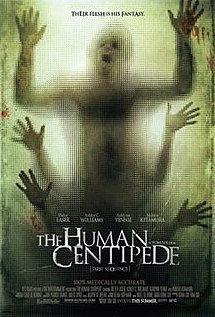
Katsuro: Hey girls! Hey mister! What an insane world we live in.
Horror is an interesting genre. Our media is saturated with reports of human violence and depravity on a daily basis. In fact, at the time of my writing, 24 year old James Holmes wounded and killed several cinema goers at a midnight screening of ‘The Dark Knight Rises’, another film that revels in the depiction of acts of terror and annihilation. Our society and culture is one in which real life crime and murder is sharply juxtaposed alongside sensationalised, no holds barred movie violence. Horror consistently lulls in exhilarated audiences. There is a definitive pull in people to witness, to inspect, and to voyeuristically be part of the dark damage and danger in others as they commit the most deplorable of acts. In 1998, artist Tracey Emin unveiled 'My Bed', a trashy ode to sex, alcoholism and bed ridden breakdowns, and called it art. In the same way Tom Six has made a film about three people being sewn together and called it 'horror'. If true horror is about presenting audiences with the vile and unimaginable, breathing life into the warped, twisted and unnatural, then Six succeeds.

I’ve long been fascinated with the horror genre; at the insight and revelation it can provide as it enables us to delve into the darker, more nightmarish aspects of some of societies sicker individuals. Tom Six’s 2010 release ‘The Human Centipede (First Sequence)’ is a film that has extracted much curiosity and controversy from horror lovers and loathers alike. Many reacted and recoiled with horror at a concept that is truly distasteful and projected in a most harrowing and relentless way. For this reason, I decided to open Pandora’s Box and watch a film that both intrigued and revolted me in equal measure.
The concept of The Human Centipede is simple. Lindsay and Jenny are native New Yorkers on a road trip through Europe. Currently vacationing in Germany, the two are destined for nightclub ‘Bunker’ to meet a companion. En route their car breaks down and they seek solace at the home of Dr Josef Heiter. It soon becomes apparent that Heiter is not the most compassionate of hosts. He pretends to call a car company to resolve the girl’s problem, lacing their water with rohypnol and watching the drug take its drowsy effect. Lindsay and Jenny awake beside a man who Heiter announces is not ‘a match’. He promptly disposes of the man and replaces him with Katsuro, a Japanese tourist.

Heiter introduces himself and presents his idea. Through Heiter, Six introduces us to a concept that sickening sinks to a yet untold level. Heiter, a retired leading surgeon sustained himself with a career spent separating Siamese twins. This idea of separation led him to a fascination with the possibility of conjoining, of completing and creating. His first attempt at concocting a pet for himself emerged when he connected three Rottweiler’s to form a ‘three hound construction’. The Dr reveals that he now intends to concoct a ‘Siamese triplet’ consisting of components A, B and C. As he anesthetises his patients, Lindsay releases her binds and escapes, sealing herself in an upstairs room, but Heiter, growing increasing aggressive at his escaped victim, appears at the window with a loaded gun, smashes the glass and follows her as she runs away and falls into a swimming pool. Heiter picks Lindsay as the middle piece for punishment and pushes a button to entomb Lindsay in the pool. The electricity cuts out and she returns to the house to release Jenny, interestingly choosing to leave Katsuro behind. Lindsay manages to drag Jenny outside but is shot in the neck by Heiter’s anaesthesia dart.

The three awaken connected and bandaged – a new perverted, unnatural creation, laid at their masters feet. Heiter attempts to ‘train’ and ‘torment’ his pet but tires of the lack of cooperation from the lead Katsuro who he taunts and teases with racist slurs. Katsuro’s screams of anguish keep him awake at night and he realises that his pet is less of the compliant subordinate that he desired. The centipede rear, Jenny, is contaminated with blood poisoning and Heiter realises that he must replace her, creating a four person centipede instead.

Two detectives, Voller and Kranz investigate the area attempting to locate the missing tourists but find themselves targets for Heiter’s groundbreaking experiment. The film ends unapologetically with the deaths of Voller, Kranz, Heiter, Jenny and the suicide of Katsuro who believes his selection as part of the centipede to be punishment for his mistreatment and neglect of his family. Lindsay alone remains alive, trapped between her two dead ‘body parts’.
What I have witnessed is a stark, bleak, brutal, nihilistic exploration of the meaningless of human life and the bizarre, moronic ease with which it can be snuffed out and stripped away with relentless, immediate, unapologetic and unforgiving readiness.
How can I organise my thoughts clearly when a wave of numb, shocked, apathy washed over me upon completion of this film?

The first issue I wanted to address was language. Heiter targets three foreign tourists; two American females and one Japanese male. Prior to this, language itself serves as an unbreakable barrier for the women when their car breaks down and a German driver pulls up alongside them. He converses with the girls in German but the three are unable to understand one another. As such he is unable to assist them and instead regresses into crude sexual facial expressions. Heiter himself speaks in German when he initially becomes angry with the girls leaving them essentially excluded from the root of comprehending such unbound nonsensical hostility. He is angry, and the girls know he is angry, but they do not know why. The language barrier is an interesting way of making that which is already, by the very twisted sickness of its nature, impenetrable and unknowable, even more maddeningly evasive. We can never bring ourselves to understand the deplorable workings of such an evil mind, but even if there was some way, some insight to be garnered through communication, this is blocked too and inaccessible. The Doctor does not want to converse with them, he does not want understanding, he does not want to be understood, he wants to use them.

Katsuro himself speaks no English or German and so he is completely alienated. He cannot ask why, he cannot plead for help and he cannot beg for escape. Lindsay and Heiter regularly converse but Katsuro, ironically the front of the centipede, is completely unable to comprehend a word the Doctor says. He cannot comfort the girls, nor can he insult the Doctor. He is simply stuck in the limbo of his own language. However, language is not needed to understand this assault, because it cannot be understood at all. The issue of language is one further barrier, but even with words, there is no way to grasp the horror and pointlessness of Heiter’s experiment.
Language is one in which Six enables us to experience the dehumanisation of his three protagonists. Katsuro in particular, in not being able to communicate with the Doctor, is reduced to no more than a yapping dog that the Doctor cannot understand need not answer to. Lindsay and Jenny, the mid and rear of the centipede are stripped and silenced of language altogether, stitched and sewn up so that Heiter need not address them. They are not the head of the centipede; they are merely its body. He has removed any autonomy and independence and any sense of rebellion, of courage and of spirit is literally stuck and sandwiched. Lindsay, who puts up the biggest fight, is rendered the most helpless.

The film also got me thinking about common horror themes; the sense of disassociation and individualism that abounds in modern day civilisation that enables so many to commit such atrocities unprovoked and often undiscovered. You may be familiar with Josef Fritzl who imprisoned his daughter Elizabeth in his basement and impregnated her. Many feel separate and isolated, culture and community has broken down and so individuals live hedonistic, secular life’s, barricaded in their own fantasies and escapes. Some escape to alcohol, others drugs, some sex, or video games, others retreat into a deeper, denser madness. How must one perceive ones fellow humans in order to be able to treat them in this way? Killers commonly proclaim that they felt distanced and disconnected from other humans, that they saw them as animals, or lesser still. On the whole, we are disconnected from nature, from animals, from others, from ourselves.
Heiter is a misanthrope. He confesses: ‘I don’t like human beings’. What he likes is the idea of a pet, a slave. He can transform human beings into something animal, something he feels is subservient and malleable.

The film is also an exploration of perversion and what constitutes a perverted act. Most cultures and civilisations, bound by some form of modesty or decency, are unravelling at an alarming rate as our concept of freedom clashes with ideas about morality and respect. Sex is no longer taboo. Instead it is sensationalised, saturated, commoditised and capitalised as never before. The film insinuates that the acceptance, tolerance, perhaps even normalcy of everyday perversion has enabled and exemplified larger acts. It is these smaller, almost unnoticeable perversions that act as a microcosm of a larger, festering truth. The driver who initially appears to want to help the girls instead makes a salacious remark about ‘fucking’ and makes crude facial gestures. Heiter seems to receive some sexual pleasure from the fantasy of his centipede. He reacts with great joy when Lindsay is forced to swallow Katsuro’s excrement. There is something pornographic about his joining and merging of the three tourists, the implied threesome, the intimate physical connection forged and the humiliation and training of his new ‘pet’. The film is asking us: what is the line? How much can we watch? How much can we take? What is an analysis of the debauch of the soul and what is simply a peek into the vapid black hole of soullessness?

The nature of quick, fast, instant access to anything, including that which was previously taboo, means that every fantasy, every desire, every need and every want from sex to violence to fast food can be acted on immediately with little pre-thought and little analysis afterward. We no longer need to mediate on why we want what we want. We can simply have it. The horror genre is constructed in such a way that it must continue to out-titillate and tantalise itself. This is something sex and violence have in common. ‘Vanilla’ sex and ‘vanilla’ violence can only satiate the hungry viewer for so long, before the baying mob craves more to satisfy their cravings. ‘Scream’ revealed a potent horror truth, a sacred rule, sequels must have a higher kill count...and the killings must be more inventive. Contrasting Hitchcock’s ‘Psycho’ and ‘The Birds’ with modern day horrors such as ‘Saw’ and ‘The Texas Chainsaw Massacre’, we can see a shift from horror of the mind (the warped Norman Bates for instance) and pure, brutal, unflinching, visual horror that leaves no room for exploration or understanding. In the Human Centipede, there is no strict, stark motivation. We are presented with a clean, sterile monster with no morals and a loose conscience, who seems to have no real reason to be doing what he does. And we like to rationalise evil with reasons because then we can understand it and box it away.

Many horror films provide us with a villain we can analyse because boy do we love to ‘understand’ the bad boy. Jigsaw is motivated by karmic redemption, Norman Bates was the victim of severe mental illness...but what intentions can we instigate for Heiter? He is an intelligent, amoral man of great precision and skill who creates a centipede because he can, because his dextrous hands can breathe life to the brutality of his every fantasy, he can create his very own monster a la Frankenstein, and in a world of separation, disillusion and veneers of normalcy, he can do just that with complete protection and anonymity. We are protected from being uncovered because we have become unknowable.
The film generated further ideas for me also....
- What is the significance of a German doctor as the films adversary? Is it a parody, a spoof of German efficiency and history?
- What is the significance of three foreign tourists as the protagonists? Is this an exploration of the idea that the ‘other’ is always excluded, ostracised and exterminated by the native?
- What is the significance of Katsuro’s playboy tattoo? Does this represent the normalisation of hyper sexuality and the commoditisation of sex?
- What is the significance of Katsuro being at the front of the centipede? Does this reflect and represent patriarchy? Do women literally have to swallow the s*** of male leadership and influence from a position of enforced powerlessness?

The Human Centipede could easily be dismissed as something sick, irrelevant and banal, but I found it both disconcerting and worryingly relevant. I think Six’s style of straightforward, merciless cruelty reveals a great deal about the fragmented psyche of supposed normal individuals who commit abhorrent crimes. Our newspapers and TV’s are littered with them. Are we really any closer to understanding the true motivation of such consuming evil?
I’d like to explore some of Six’s own revelations and inspirations regarding the making of this film.
- Six explained that the motivation for this story came from a joke shared with a friend regarding an appropriate punishment for paedophiles. This for me introduced an interesting truth – perfectly normal people can envision pure evil as punishment for something they consider distasteful and morally abhorrent. Evil can be a reaction to other evil
- Six loathes political correctness and the Human Centipede is definitely as un-PC as they come
- Six was fascinated with shows such as Big Brother and more importantly the idea that people partook in unusual activities when they felt they were unmonitored. We are conditioned to behave a specific way when we are watched but when we are not, what comes out? What outlet do we have for the ‘darker’, uglier aspects of our natures?
- Six reflected that 'The Human Centipede' is in part a look at fascism and the ripples and repercussions of guilt felt by generations of ordinary Germans in the aftermath of WWII. He explained the film as a “grotesque [parody] of the German psyche”. We can dehumanise others when we feel they have dehumanised others in turn. History repeats itself. We are guilty of the very thought processes that have incited hatred in every corner and quadrant of the world
- Six enjoys using and breaking various horror movie clichés, such as the naive, gullible leads, the wandering through the woods and the broken down car. This sets an uneasy contrast between audience expectations and the gravitas of the subject matter
I believe that the horror genre continues to be an essential medium for the focus and exploration of our darker selves. I believe horror can be an important outlet and assist us with grasping and comprehending others completely alienating acts. Was this a film that needed to be made? This is not your typical slasher movie, nor is there a satisfying conclusion where there is a glimmer of hope for the victim. This is bleak, dire material, much like ‘The Texas Chainsaw Massacre’, ‘Dogtooth’, 'Antichrist' and ‘Melancholia’. There is no rhyme or reason, no sense nor logic, to the calm, static madness of Heiter and the insanity of his scheme. Is this a film to generate discussion or is Six merely seeing how far he can push us, laughing all the way? There are sensitive, psychological, poignant horrors and then there are relentless road runners that go straight to hell and don't dwell.
Undoubtedly, The Human Centipede will continue to be a cult classic, dividing and polarising audiences for some time to come.

No comments:
Post a Comment